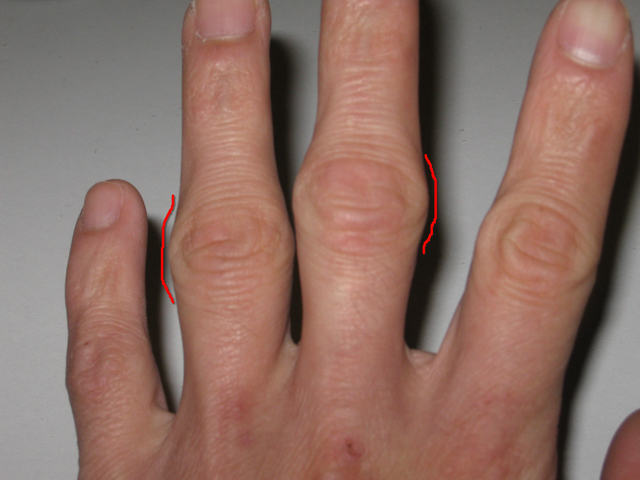|
Finger Arthritis? By Pierre Mouchette | Bits-n-Pieces Our fingers are essential! We use them constantly, all day long. When arthritis affects the fingers, everyday tasks become difficult and painful. This article provides information about arthritis in the fingers, what causes it, and what you can do to help keep your fingers moving.
Three types of arthritis commonly affect the fingers: Osteoarthritis – sometimes called wear-and-tear arthritis, is the most common type of finger arthritis. Osteoarthritis causes normal cartilage to wear away, exposing the bare bone at the joints. The most frequently affected joints in the hand are the knuckles of the mid-finger and fingertip and the joint at the base of the thumb. Rheumatoid arthritis - causes a different type of joint destruction. Rheumatoid arthritis is an autoimmune condition that affects the whole body, causing the immune system to attack the soft tissues surrounding the joints. The most commonly affected joints in the hand are the knuckles at the base of the fingers (the MCP joints). Gout - a condition that occurs when crystals develop within the joints. These crystals can form in one or more joints when there is too much uric acid in the body. While the big toe is the most commonly affected part of the body, gout can also develop in finger joints. Rarely do other types of arthritis cause problems in the fingers. Finger Arthritis Symptoms
Rheumatoid arthritis often causes similar symptoms. However, rheumatoid arthritis can cause hand deformities, and joint inflammation can cause finger joints to become crooked and bend away from the thumb. Causes A joint is the part of your body where two bones come together. Bones are cushioned by cartilage, which allows smooth movement between the adjoining bones. When the cartilage is damaged, arthritis develops. Our daily activities become complicated when our fingers cannot bend and move normally. Treatment The treatment of finger arthritis depends on its underlying cause. Treatment focuses on managing the symptoms, maintaining and improving function. Treatment options include: Anti-Inflammatory medications - are often recommended for treating the pain of finger arthritis, and they help decrease inflammation and swelling around the joints. You should always check with your healthcare provider before starting any new medication, even over-the-counter medications. Cortisone injections - are a potent anti-inflammatory steroid medication that can be useful in limited applications in the hand. While it is not beneficial to have frequent cortisone injections, an occasional shot may help to calm a flare of arthritis. Joint supplements - consist of glucosamine and chondroitin, two major building blocks of normal cartilage. These supplements are very safe to use. Although the clinical data supporting their use is weak, many say they are helpful. Hand therapy - performed by an occupational therapist, helps maintain motion and prevent stiffening of the joints. Ice and heat treatment - ice and heat treatments can improve joint stiffness and range of motion. Most people with finger arthritis find that warming the hands with a warm washcloth or in moderately hot water helps relieve the stiffness of arthritic fingers. Splints - help to relax and rest the joints. Splinting should be done for limited periods to allow relief without stiffening the joint. Surgery If non-surgical treatments do not relieve symptoms, surgery may be necessary. Several different procedures can be done, depending on the joint involved and the effects of your arthritis. Your healthcare provider may recommend removing bone spurs or fusing or replacing the joint. Joint Fusion - the most common surgery for finger arthritis is finger joint fusion. This procedure holds the knuckle in a fixed position to prevent joint movement. The joint becomes stiff forever, which limits your range of motion, and the pain is usually alleviated. Your healthcare provider can straighten deformities and remove bone spurs during this procedure. Joint Replacement - finger joint replacement can be very effective for some people. An artificial finger joint can maintain mobility of the joint without the pain of arthritis. Deformities and bone spurs can also be treated during this surgical procedure. Note: Finger joint replacement is only considered for sedentary or elderly individuals because the artificial joints are not designed for strenuous activity or heavy labor. The implants, made of metal, plastic, ceramic, or a combination of materials, can wear out over time and must be protected from too much activity.
0 Comments
Your comment will be posted after it is approved.
Leave a Reply. |
Archives
May 2024
|
